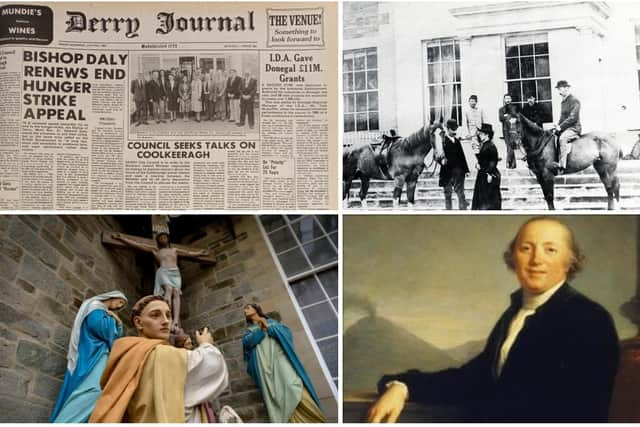EDITORIAL: Derry Journal reaches 250 year milestone in 2022
and live on Freeview channel 276
Looking back at life and events of the 1770s, it is remarkable how much of the region’s past remains tangible today, and yet it is also a world much changed.
When the Journal was first published in June 1772, the ancient city of Derry was already over a millennium old and was well established as a port of global significance. Indeed early editions of the Journal listed the names and origins of people who came from across Ireland to board ships docked on the Foyle bound for the promised land of America.
Advertisement
Hide AdAdvertisement
Hide AdMeanwhile a linen industry was taking off in the city and its population was growing rapidly as settlements sprang up outside the 160-year-old City Walls. It was, in fact, in the 1770s that a Linen Hall was built on the city centre street named after it and which still exists today, Linenhall Street.


Globally, slavery still existed but a landmark case in England in 1772 saw an African man, James Somerset, who had been taken into slavery by an English man in north America, freed by a judge after challenging the person who wanted to sell him in Jamaica, while the famous Boston Tea Party incident in 1773 fuelled discontent between George III’s England and the colonies in America just as James Cooke set sail on an expedition that would discover Antarctica.
Here at home the famous and colourful Bishop Frederick Augustus Hervey had been installed as CoI Bishop of Derry, taking up residence in what is today the Masonic Hall with its sprawling gardens (now Bishop Street car park). It was this Bishop who built Downhill and the famous Mussenden Temple on a cliff overlooking Benone and Lough Foyle, and who is perhaps most noted for his conciliatory stance towards the native and largely Catholic population of the wider region. He even donated £100 to the construction of the Catholic Long Tower Church, situated nearby and built on the site of a once massive cathedral for the Templemore parish and an ancient round tower, with links back to the 6th Century and St Columba.
There is less material that has survived on the plight of the ordinary people but it is known that across Ireland poverty was rife during the 1700s. Discriminatory laws barring Catholics and also Presbyterians from holding political office and Catholics from buying or acquiring land resulted in the native Irish Catholic and dissenter populations owning next to nothing, after the carve up by colonists over preceding generations. However by 1772 change was afoot and the course of our history would be set. Within the next 20 years some of the discriminatory laws would be repealed so that by 1793 some Catholics could vote, buy land and marry a Protestant (although they still couldn’t be MPs). By then, Wolfe Tone had created the United Irishmen and risings flared across Ireland inspired by the revolutions in France, the US and elsewhere.
Advertisement
Hide AdAdvertisement
Hide AdFor the more affluent however, life continued as it had. Boom Hall in 1772 was acquired and rebuilt by James Alexander (who would later become MP for Derry and whose descendant would marry Cecil Frances Alexander) along with lands at Moville, while Prehen House was in the possession of the Knox family, and Elagh Castle- once a stronghold of the O’Doherty clan - was by now already in ruins. It’s tower can still be seen today high above the Buncrana Road near the border with Bridgend.
It is fascinating to think of how the north west has evolved over the past two and half centuries. It is remarkable that so much of our heritage remains today and lamentable too that so much went unrecorded.
Throughout those years however the Derry Journal has been a constant, a key observer of local events, the paper of record which has played a vital role in bringing the world to the people of the north west and the representing the people of the north west of Ireland to the world. It has been an important voice, and many times a lone voice, championing local people across Derry, Donegal and Tyrone over those two and half centuries.
Many of you of all generations will remember scouring the pages of the giant Friday Journal for the latest news and sport, having your photo in the paper, maybe attending a Journal dance, looking up ads for jobs, houses, services and placing memoriams down the years.
Advertisement
Hide AdAdvertisement
Hide AdArguably, the biggest changes for our industry and in society generally have occurred over the past 20 years but we hope to be telling the story of this city and region for many years to come in print and online at www.derryjournal.com.
Brendan McDaid
Editor, Derry Journal